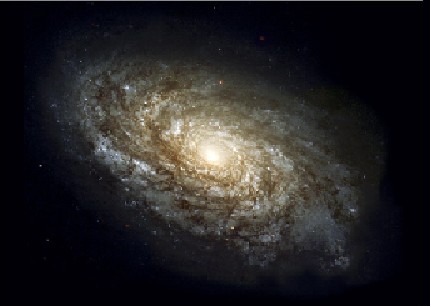
One of
Vera Rubin's important contributions to astrophysics is the collectionof
conclusive data pointing to the presence of dark matter in galaxies. These
data are measurements of the orbital velocities of interstellarmatter in
galaxies. She studied the variation of these velocities with distance from the
center
of the galaxy.
It is assumed that matter orbits about the center of a galaxy owing to a centripetal force which is the gravitational attraction of other matter in the galaxy. Assuming all other matter in the galaxy is luminous, astrophysicists cannot account for the centripetal accelerations observed. These can be accounted for, however, if additional matter is present. Consequently, Rubin's measurements were of fundamental importance as empirical evidence for dark matter.
Rubin determined the velocities as a function of distance from the galactic center of clouds ofionized hydrogen (in astrophysical terminology, HII regions). This was done by measurement of the Doppler shift of theirH-alpha emission lines. The hydrogen cloudsmove with the stars and other visible matter in the galaxies. Their velocitiesare more easily and directly measured than other visible matter.
Rubin found that the velocities of the clouds did not
decreasewith increasing distance fromthe galactic center, and in some cases
even
increased a little. This is in striking contrast to the decrease in
velocitywith radius predicted by Keplerian motion, which would occur if
allthe mass of the galaxy were concentrated in the center of the galaxy. In this
case,
one has the result that the velocity decreases inverseley as the square root of
the radius
(distance from center); i.e., Newton's law of gravity
yields


Thus astrophysicists have been led to believe that there is matter outsidethe bulge which has not been observed but exerts a gravitational forceand 'raises' the velocities of the clouds above that expected from theknown distribution of visible matter.
Detailed observations were first made by Rubin and W.K. Ford of theAndromeda galaxy and published in "Rotation of the Andromeda Nebula from a Spectroscopic Survey of Emission Regions," Astrophysical Journal 159:379 (1970). They then made observations of over60 other spiral galaxies which apparently confirmed that the presence of dark matterwas a general phenomenon ["Rotation Velocities of 16 Sa Galaxies and a Comparison of Sa, Sb, and Sc Rotation Properties," Astrophys. J. 289: 81 (1985), with D. Burstein, W. K. Ford, Jr., and N. Thonnard].
Earlier, the astronomer Jan Oort
hadfound that the orbital velocities in the Milky Way do not decrease with
increasing
distance from the galactic center as expected. However, he did not speculate
the cause
to be dark matter. Instead, he felt that the apparent anomaly would be
clearedup by better observations of matter in the Milky Way. In
1933 another astronomer, Fritz Zwicky, suggested that dark matter might exist
based onthe velocities of galaxies in galaxy clusters. However, there
wereother possible explanations for the data at the time and his argumentwas not
conclusive. In 1973 Peebles and Ostriker provided a theoreticalargument
for the presence of dark matter in galaxies. However, Rubin'swork was the first
clear, observational evidence for dark matter as animportant and general
phenomenon in galaxies other than our own and broughtthe subject of dark matter
to the forefront of astrophysical research.